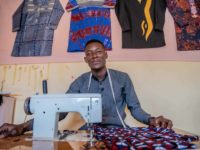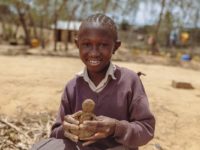Releasing children from poverty in Jesus’ name. It’s a simple statement that describes what we’re all about. But really, how does it work? How do we release children from poverty in Jesus’ name?
Brandy Campbell spoke with the ministry leaders of our child development model programs to give you an inside look at how we transform the lives of children in poverty. We’ll share their insights, thoughts and expertise over the next few weeks, but today we begin with Emily Kagiri and the Child Survival Program.

In 2007 Emily Kagiri moved with her husband and children from Kenya to Colorado Springs to take on the role of Child Survival Ministry (CSM) Director here at Compassion. She believes God began preparing her for this role when she was still a child herself.
1. How has God uniquely equipped you to work with the Child Survival Program?
When I was about 18 months old my grandmother was my caregiver. During this time I contracted tuberculosis (TB). There was no treatment for TB during these years, and my family had to completely depend on God for my healing. In Africa we highly believe in divine healing. What else would we do if there was nowhere to get help? While I was recovering, the government of Kenya started providing nutritious foods for the malnourished children in the community. This was my very own child survival program. I became healthy, strong and survived to face life in my world. For the rest of my life, I knew that helping babies like me was what God was calling me to do.
2. So, would you say that your childhood and healing gave you a passion for infants?
I have been there. My heart reaches out for these babies and mothers because I know if only we can have men and women giving to this program, many children will receive hope in life, many will survive the challenges of life, and women will learn who they are in God and will believe in their children.
3. You were instrumental in the success of CSP in Kenya. What made you decide to leave Africa to work with CSP on a more global level?
While I was still in Kenya, God gave me an opportunity to speak up for the children in the Child Survival Program as Compassion Kenya’s CSM director. I knew that if given an opportunity to speak up and touch the lives of women and babies at a larger scope, I would do it. My passion is to help people understand the global need, difficulties and situations of babies and pregnant mothers living in poverty in developing countries, and to show them that if only people would respond to this need many children would see their future years in life and become what they dream to become. So God decided that coming to the States would be the way to use this gracefully given potential. I only followed the leading of God — thank God He had prepared my family for this transition. The bottom line is that my being here has nothing to do with me but everything to do with God.
4. What makes the Child Survival Program unique among other organizations that work with infants and mothers?
The uniqueness of Compassion’s Child Survival Program stands out in one phrase: spiritual development. The fact that our Child Survival Program touches the spiritual being of a mother, a child, a family and a community is unique and makes all the difference in the lives of that family, baby and mother. CSP is a one-to-one home-based program in which staff members visit homes and educate mothers in the child’s own environment. It is then that the actual needs of the baby, mother, family and community will be known, seen and met accordingly.
5. Why did Compassion choose a home-based model for CSP?
The Child Survival Program is primarily home-based because this allows us to address the immediate needs of the baby and mother. When you get into a community and find that most children are malnourished, the best way to get to the root cause of this problem is to visit families in the community. During your visits, you will see and learn what children are fed and why. You also observe any cultural reasons for certain practices. Then you come up with an action plan from a knowledgeable perspective. In home visits, CSP workers teach mothers about parenting practices, including hygiene and nutrition, using their own locally available foods. Only during home visits can you assess whether what you have been teaching has been put into practice. Home visits create one-to-one relationships where mothers can confide in you and share their innermost fears and problems.
Come back tomorrow for the rest of Brandy’s interview with Emily.
Brandy Campbell is a feature writer at Compassion International. When she’s not chatting with Compassion execs, Brandy writes newsletter and web stories about Compassion’s ministry to children in poverty.







0 Comments |Add a comment